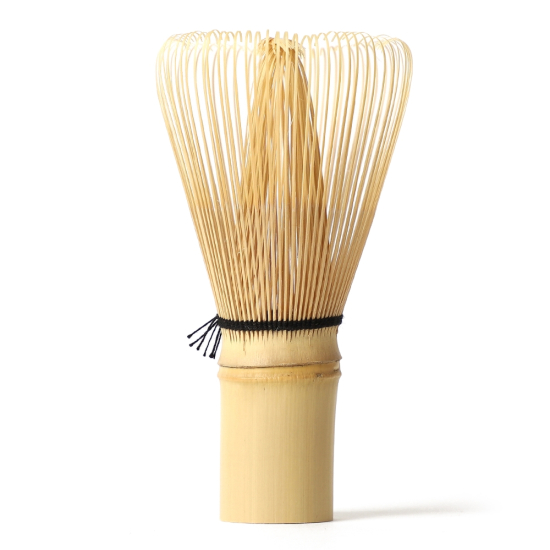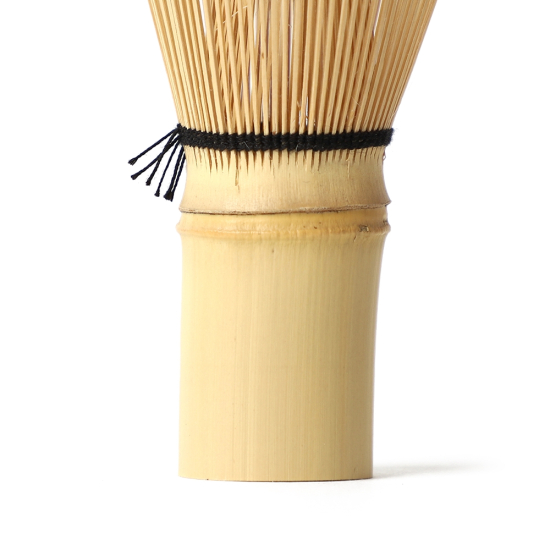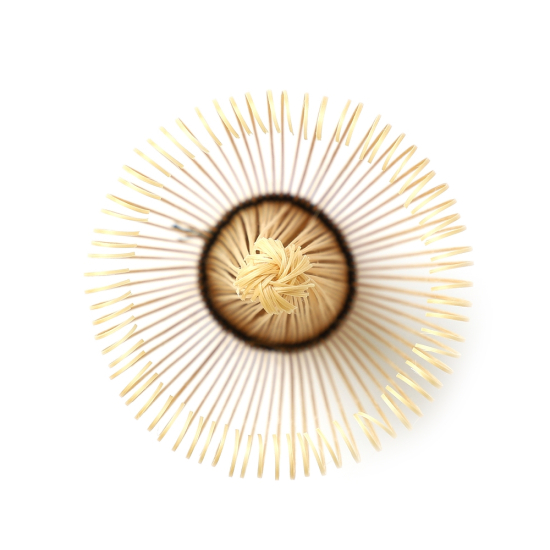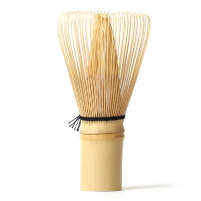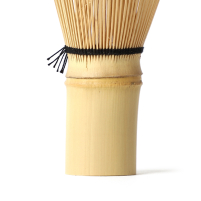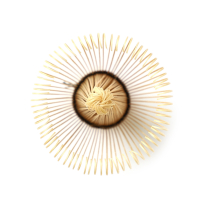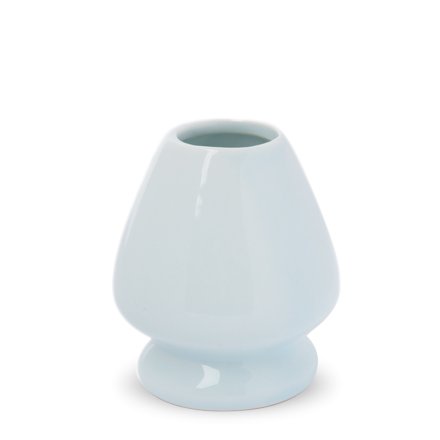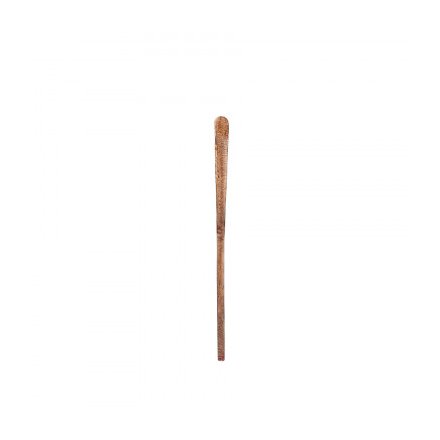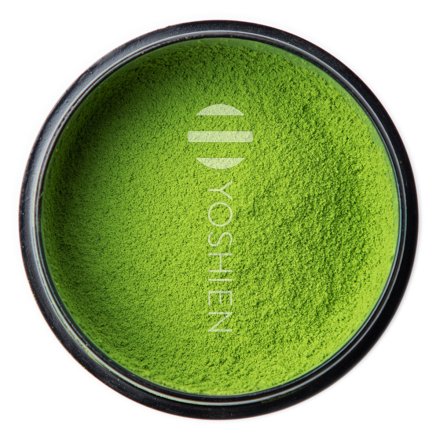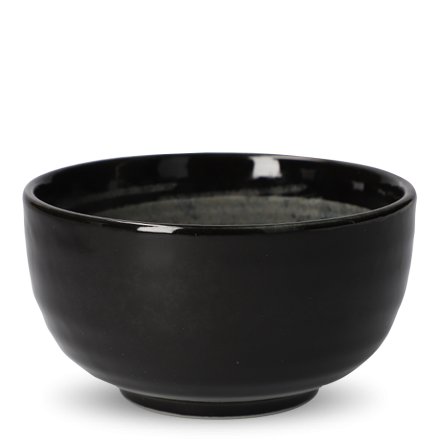The white bamboo used is cold-resistant with a diameter of 3-10 centimetres, can grow up to 15 metres high and has the smallest and most numerous vascular bundles, making the surface dense, thin and easy to split. Because of the stalks' natural powder white colour, the variety is known as hachiku 淡竹 ("pale bamboo"). To ensure the chasen is sturdy enough, only bamboo that is about two to three years old is used in its production. The bamboo is cut to the right length, roughly quartered and then separated from the soft inner material so that only the sturdy outer layer remains. These are then further divided until the desired number of tines is reached, and then divided into inner and outer tines. A thread is run between them at the bottom so that they stay in place. To create the curved shape, the tines are pulled upwards with a knife, similar to curling a gift ribbon; this method applies pressure, keeping the tines in shape. Next, the individual tines are refined and gently sharpened to give the matcha as little surface area as possible to settle. Finally, the tines are pressed into shape until the desired result is achieved.
Matcha Whisk
Urasenke Shiro
Takayama
| Type | Urasenke-style matcha whisk (chasen) |
|---|---|
| Tines | 100 |
| Origin | Takayama, Japan |
| Dimensions | 12cm x 6cm |
| Weight | Approx. 15g |
| Material | White bamboo (Hachiku 淡竹) |

Takayama
The city of Takayama in the Nara district of Japan is considered to be the birthplace of handmade chasen. Professional production methods are typically well-guarded secrets that are passed down from one generation to the next, and today there are only around twenty registered family businesses manufacturing chasen in Takayama, producing more than 90% of all chasen sold in Japan. Legend has it that Murata Jukō, the founder of the modern Japanese tea ceremony, was the driving force behind the chasen. When he began to link the tea ceremony more closely with Zen Buddhism over 500 years ago, he created the term "wabicha". The aesthetic concept of "wabi-sabi" describes, simply put, the beauty of imperfection, particularly in nature. Living out this concept in tea, Jukō asked his friend Takayama Sōsetsu to make him a suitable utensil with which to prepare powdered tea, leading to the creation of bamboo chasen.

Chasen 茶筌
The chasen is a tea utensil used in the preparation of matcha, handcrafted from a single piece of sturdy and flexible bamboo. There are slight variations in style and colour depending on the shape, number of tines and the type of bamboo from which it is made. Each Japanese tea school has its preferred style, depending on the season, the type of tea ceremony and the tea bowl (chawan) used. The Urasenke (裏千家) tea school, for example, prefers a chasen made of white bamboo with many tines, whereas the Omotenke (表千家) uses a chasen made of black bamboo with fewer, coarser tines. The last of Japan's three great tea schools, the Mushanokōjisenke (武者小路千家), prefers chasen made of black bamboo with either very coarse or few tines, which can also be completely straight. Generally, however, normal thin usucha is whipped and foamed with a chasen with 80 to 120 tines, while thicker koicha is whipped with a chasen with 60 to 80 coarser tines to evenly mix a larger amount of powdered tea.
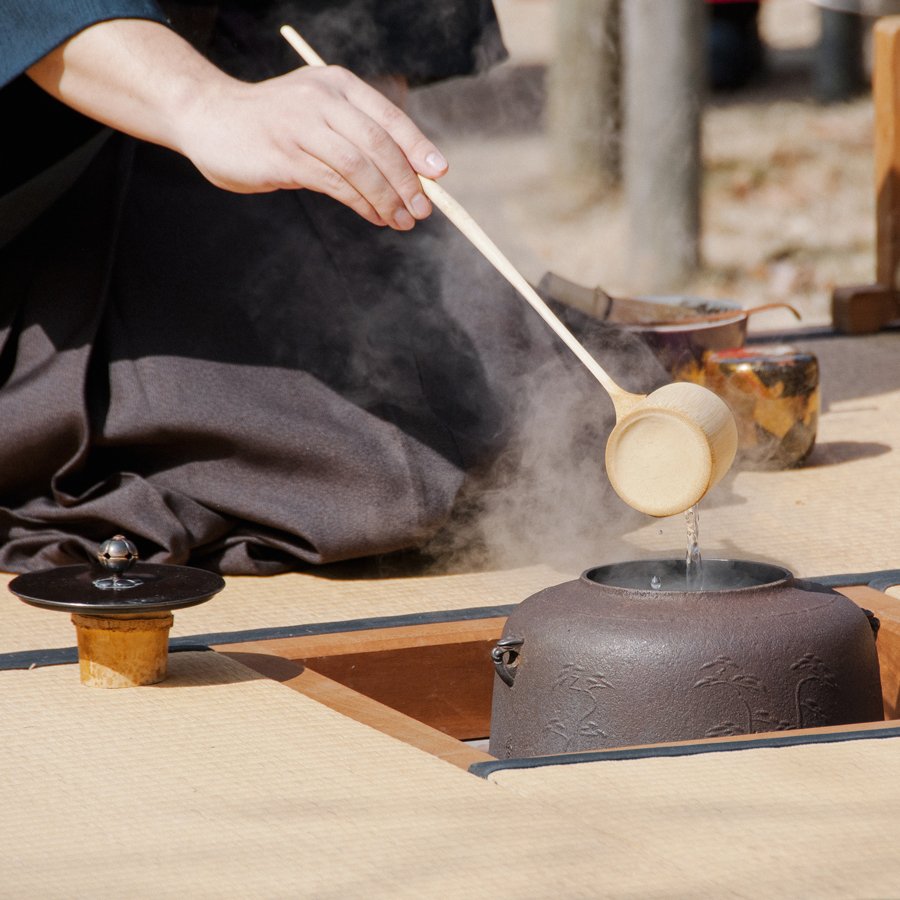
Urasenke 裏千家
The largest of the three schools ("Sansenke" 三千家), originating from the bloodline of Sen no Rikyū (千利休), prefers chasen made of white bamboo and with many tines. The intention of the urasenke is to create a dense foam on the surface of the matcha, which is easier to achieve with a higher number of tines. When drinking, the foam should help to take in more air, naturally enhancing the aroma. The white bamboo fits particularly well with the Urasenke aesthetic, which highlights each object individually as a work of art in its own right. It often happens, for example, that the matcha bowl (Chawan 茶碗) does not match the matcha container (Natsume 棗) in colour, allowing each to shine on its own. The matcha whisk thus often provides a wonderful contrast, neither overshadowing nor fading into the background when placed alongside other beautiful objects.
Production
Application
To create the signature matcha foam, a chasen is undoubtedly the best tool. First, add hot water to your matcha bowl and place the chasen in the water for a few minutes. This softens the bamboo and prevents you from breaking the tines of the chasen. Now pour away the water and dry the bowl so that the matcha does not clump together. Once water has been added to the matcha, it is important to move the chasen properly; avoid circular movements or a typical whisking motion, as this will result in little or no foam. Hold the chasen at an angle of about 90° in the bowl and touch the bottom lightly. Do not press the chasen against the bowl, just let it gently touch the bottom. Now move the Chasen straight back and forth from the wrist while moving your arm to the left and right. This creates a "W" or "M" movement. The faster you perform this movement, the quicker and easier a wonderful foam is created. Practice makes perfect.
Care
Soak the chawan in warm water for a few minutes before use so that the tines soften and unfold. If you prepare the matcha in a chawan, avoid touching the sides when whisking so that the shape is maintained and the struts do not break. Also, do not press the chasen too hard against the bottom of the bowl. After use, soak the chasen again in warm water, repeating the same motion until the powder is removed. After cleaning, shake off the excess water and allow the Chasen to air dry completely. A matcha whisk holder (Chasen Yasume 茶筌休め) is strongly recommended for this. Otherwise, let the chasen dry facing downwards to avoid water collecting in the handle, which could lead to mould. If mould forms, put it in boiling water for a few minutes and then let it dry fully.



